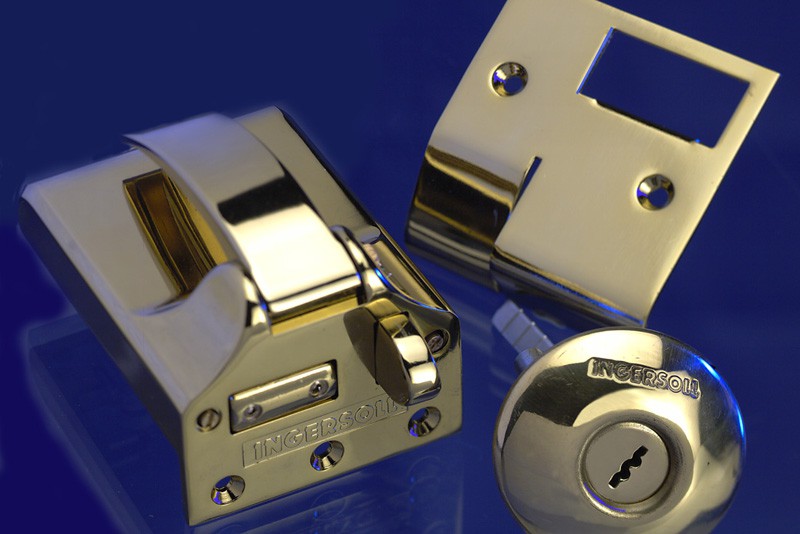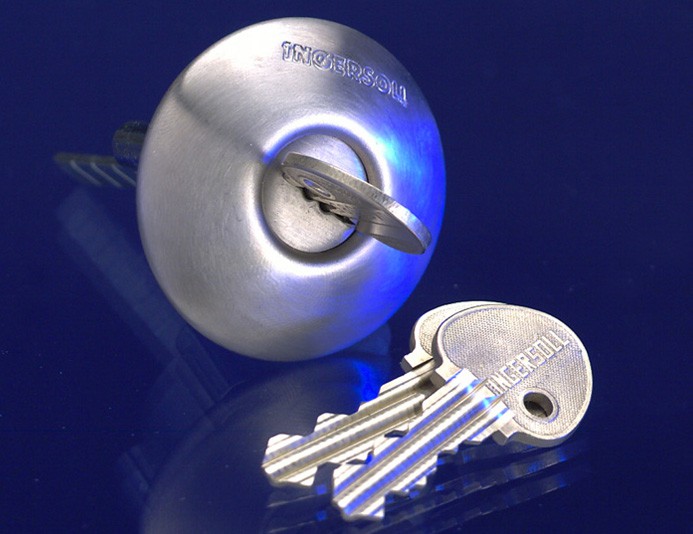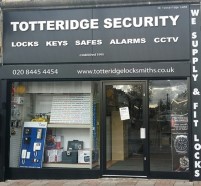Ingersoll Locks

Here at Locksmith Totteridge we specialise in Ingersoll Locks.
We are proud to say that our knowledge of the Ingersoll Lock range and history is unrivalled.
Ingersoll Locks Limited (now Ingersoll Security) was founded in Forsyth Road, Sheerwater, Woking on March 3rd 1940. Ingersoll Locks was set up as the lock manufacturing division of The Ingersoll Watch Co. which had already been trading successfully for nearly 50 years, having been incorporated by brothers Robert and Charles Ingersoll in 1892.
The Ingersoll brothers were assisted by no one less than Mr. Henry Ford himself in setting up the company.
The sons of Orville Ingersoll, a farmer from Michigan they founded the business in New York and were soon producing a range of popular watches. Ingersoll has a long heritage and is renowned for the first automated production of pocket watches and watches. The Ingersoll brothers soon created the 1 dollar watch which was hugely popular; they produced over 1 million pieces. The 1 dollar watch was so popular they had to buy and setup more production plants, at the same time their product range was expanding with some pioneering technical refinements; then came the smallest pocket watch ever produced.
Click the Enquire Now button below to complete the enquiry form and one of our friendly experts will contact you shortly.

In 1922 during the depression that followed the First World War, The Ingersoll Watch Co was declared bankrupt. Its assets in the USA and The UK were purchased for £1.5m by The Waterbury Clock Company. Amongst the UK assets was £272,000 mainly in cash and a building that that the company had built by the name of Ingersoll House. The building is located at 7-9 Kingsway, Holborn, London, WC2B 6XF and still stands today. Ironically, we as locksmiths have actually carried out work in this building. The Ingersoll Watch Company is one of the oldest and finest watch makers in America and still produces a range of amazing timepieces.
Ingersoll Locks initially manufactured padlocks which were well received in the market place. With modifications they soon produced their famous 'Impregnable' high security padlock range which stormed the world market. Never before had there been such a strong padlock. A transatlantic partnership with American Sargent and Greenleaf lead to a joint-developed version of the Impregnable that it was used on American nuclear missile silos, such was the reputation of Ingersoll. Over investment on the part of Ingersoll in this particular venture proved almost disastrous for the company but they recovered.
Ingersoll Locks Ltd established themselves as a world-leading manufacturer of high security locks and as such supplied banks, military establishments, government agencies, transport firms and security-conscious industrial and commercial companies as well as householders. The award-winning range of Impregnable padlocks illustrated the creative approach to design which has helped to earn the company its reputation.
Sadly, the names of the product engineers and designers from those very early days are unknown.
What we do know is that four gentleman (possibly more) were responsible for the later product designs in the 1950's, 1960's, 1970's and 1980's. These talented chaps were William Ernest Stubbs, Alan George Kenney and Jack William Taylor and his son Andrew Taylor. If any readers of this article can add any additional names of designers or engineers I would be happy to hear from you. If I have omitted anyone important here, I apologize, please set me straight.
The original Ingersoll patent which led to the development of the Impregnable range was granted in 1949 for a method of securing the U-shaped shackle into the lock by means of two ball bearings being driven by a cam mechanism to engage in grooves in the toe and heel of the shackle. Similar methods have since been adopted by many other manufacturers. The body of the padlock is made up of steel laminations which are locked together, copper brazed, case hardened and finished in dull nickel chrome, leaving an internal chamber to house the unique Ingersoll 10-lever cylinder which is used in nearly all Ingersoll locks. This cylinder has at least twice as many levers as most other locks, providing an exclusive combination for each user and being highly resistant to picking devices, skeleton keys or drilling. We can trace back the now familiar 10 lever key design as far back as 1949. If anyone has photographs of these early products and would like to see them included on this page please get in touch. Likewise any interesting of historic Ingersoll pictures would be greatly appreciated.
This left the shackle itself as the most vulnerable point and Ingersoll - always aiming to keep one jump ahead of the thieves - set about trying to find a method of toughening the shackle. But every attempt to improve the metal's resistance in one way meant compromise in another direction, and compromise is not permissible where security is concerned. So it was decided to tackle the problem in an entirely different way to protect the shackle from attack by bringing the shoulders of the padlock case up to completely surround it. This anti-wedge version was introduced in 1967, together with a patented design of notched padlock bar to fit tightly over the top of the padlock. A high shoulder version, open at the front and back only, was marketed in 1968. Standard open and close shackle models make up the range, the production of the different bodies being simplified by their laminated construction - with additional layers simply added to the basic shape for each model. The shackle is cyanide-hardened steel, with a tough industrial chrome plating to resist cutting. The padlocks cannot be "shocked" open and even if a way of obtaining leverage is discovered will withstand pull pressures of more than four tons.
These padlocks are so secure that the United States Government decided to standardize on them for all high security jobs requiring padlocks. Among the tests which the locks had to endure before winning this approval was the insertion of dynamite in holes drilled in the case in an attempt to blow off the shackle, heating for an hour in a furnace at 2000 degrees F, and trying to pick the lock with special tools and with the assistance of radiographs. Another satisfied American customer is Con Edison, who before fitting Ingersoll padlocks lost $450,000 worth of tools in one year from tool carts in the streets of New York: in the first ten months after fitting ''Impregnable'' locks, losses were only $500.
Ingersoll recognised then and today that security does not begin and end with a good lock. For many years the company issued no key blanks to the locksmith trade and would itself only provide duplicate keys on receipt of a request bearing the signature previously agreed with the individual customer. Because the special 10-lever cylinder is used in other Ingersoll locks, the customer is able to have one key which will operate different types of locks. The locks can be arranged in master keyed groups so that, for instance, a head of depart can open only the locks in his department while the managing director has a master key which will open locks in every department.
Eventually the patent expired on the 10 lever key design and key blank manufactures such as Silca and Davenport Burgess started to produce compatible blanks that were available to the trade. Ingersoll themselves also began to distribute 'original' blanks and many of these are still in circulation today. They can be easily recognised as on one side they bear the 'Ingersoll' name and on the other side where you would normally see the unique key number, it will most likely be blank with no stamping or engraving.
Key numbers and key series themselves are usually made up of three numbers then a letter of the alphabet and then three further numbers. For example, a typical modern key number could be 123 S 456, or 123S456. The letter 'S' is the current series, but we have seen D, N, A, and on railway and military use M. Many Royal Navy ships, still use Ingersoll locks and padlocks onboard and we at Totteridge & Whetstone Locksmiths are proud to be the main suppliers of Ingersoll Locks to the Royal Navy.
Another small matter of trivia, despite what a certain shoe-repairer over in Muswell Hill believes, Ingersoll Locks are in no way connected to Ingersoll Rand*, which is a company that simply has a similar name. You know who you are GG.
Ingersoll are fully aware that because their locks have such a high reputation and are therefore used for the most difficult jobs, these installations are the target of the most intelligent and persistent thieves, terrorists and spies. “We can never sit back, for villains are always finding new ways of attacking our locks, and we have just got to keep ahead. We cannot afford one mistake, for our whole reputation is at stake,” says Robert Judd, Ingersoll's sales director. “We therefore keep in close touch with the police and with insurance companies, and we make sure that we are told of any burglary or attempted burglary which involves an Ingersoll lock in any way.”
“We recognize that security is a concept, and cannot be isolated into particular pieces of hardware: we therefore offer an advisory service to customers to analyze their whole lock security problem, even when it does not concern our products.”
Door locks do not appear in Ingersoll's line up until 1950 when they launched the Ingersoll D20 (photo needed please). This is where my own interest and fascination with Ingersoll Locks stems from. My Grandfather was the locksmith who actually installed the very first prototype Ingersoll D20 on a house on Magna Carta Island on the River Thames. The D20 was the first door lock (night latch) to use the double side ten lever key design. The key was slightly longer than the more familiar modern design. The lock itself was larger that the SC71 and incorporated a hook bolt design and also benefited from a key hole on the inside of the lock, directly into the lock body. Uptake of the D20 was rapid, major market penetration was in the west End of London where it became a real contender for Banham's Union based nightlatch.
In 1951 Ingersoll Locks Ltd who by then were based in Ruislip were asked to provide the locks for the Festival of Britain Exhibition on the South Bank of The River Thames in London. Ingersoll took the opportunity to exhibit their products to visitors attending the exhibition and this is where the discerning and security-conscious public's attention was focused on truly impressive locking devices, the likes of which simply did not exist at that time.
The next door lock was an early version of the SC71 which was launched in 1972 and in various guises is still available to this day. Originally called the 'Impregnable No71 Lock", the SC71 was first available in four finishes, polished chrome, satin chrome, polished brass and a bronze finish. The bronze finish was dropped as an option in 1992 leaving only the three remaining finishes. The key series used were initially 'A' from 1972 to 1978. Then came 'N' which was used from 1978 to 1987. Lastly form 1987 to date was key series 'S'.
A non-double locking version SC73 was introduced in the mid 1980's for use on communal doors and is often used in conjuction with an electronic release mechanism linked to intercom type entry systems. (all available by calling 020 8445 4454).
The Ingersoll 10-lever design was also use on various mortice locks over the years, notably the SC74, SC75 and SC76. All of these were hook bolt designed, Ingersoll own phrase was 'Claw Bolt'. There was even a safe made that utilized the cylinder from a SC74 as it's lock.
Ingersoll Locks also patented several excellent Mortice locks including, the M50, M51, M52 & M53. Most notable of these was the M6 which was a revolutionary 6 lever design.
Ingersoll Locks Ltd The company was sold to Yale, in April 1988, for £2 million, by its then owners, Alumasc Group. At the time it had a work force of 100. In the 1980s all production moved to Yale's Willenhall site.
Ingersoll is now part of the Assy Abloy Company but is still listed as a separate company registered in the UK. The company number is 00359973
*Ingersoll Rand is a global diversified industrial company founded in 1871. The Ingersoll Rand name came into use in 1905 through the combination of Ingersoll-Sergeant Drill Company and Rand Drill Company. There is no known connection between Ingersoll Locks, Ingersoll Security and Ingersoll Rand.




